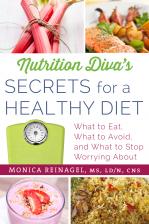How Cooking Affects Nutrients
Don’t pour all the vitamins down the drain. Find out how to keep more nutrients in your food.

Thanks for your question! Cooking or reheating foods can diminish their nutritional value because some vitamins are degraded by heat. One quick and dirty tip for retaining maximum nutrition in your food is to minimize cooking time.
Heat isn’t the only problem, though. When you cook foods in water or other fluids, some of the nutrients end up leaching out of the food and into the cooking liquid. So, another quick and dirty tip is to incorporate cooking liquids into the finished dish whenever possible.
A Few Details
Now, some nutrients are more affected by cooking than others. Calcium is pretty sturdy, for example, while vitamin C, folate, and potassium are quite fragile. Different cooking methods also affect various nutrients differently.
As a general rule, minerals can take the heat. In fact, dry heat, such as baking or roasting hardly affects mineral content at all. Vitamins, on the other hand, seem to do slightly better with moist cooking methods, such as boiling—mostly because the cooking times are shorter.
A large raw potato, for example, contains a decent amount of both calcium and vitamin C. If you bake the potato, the calcium content remains the same but you lose about 60% of the vitamin C. If you boil the potato instead of baking it, you’ll lose about half the vitamin C but, in addition, you’ll also lose about three-quarters of the calcium.
When you cook foods in water or other liquids, both vitamins and minerals leach out into the cooking liquid and end up going down the drain. If you can figure out a way to include the cooking liquid in the meal, you’ll salvage a lot of that nutrition. For example, when you make vegetable soup, a lot of the nutrients from your vegetables may up in the broth. But that’s okay, because you’re going to eat the broth too.
You can also use vitamin-rich cooking liquids to make rice or couscous, thereby recapturing a lot of those vitamins. Another good option is to steam vegetables in a rack placed above boiling water. That way, the vegetables don’t actually come into contact with the water so more of the vitamins stay in the veggies. Some still end up in the water, however, so you can use that water to cook with as well.
Guidelines for Preserving Nutrient Content
So, if you’re trying to get the most nutrition out of your foods, how you prepare them can make a big difference. Here, in order from worst to best, are your options:
Worst: Cook foods for a long time and throw away the cooking liquid.
Better: Boil or stew foods but incorporate the cooking fluid into the dish (or use it in another dish).
Good: Steam foods, which minimizes contact with water or microwave them, which minimizes the cooking time.
Best: Don’t cook them at all. I’m not saying you should never cook anything. But at least some of the fruits and vegetables you eat each day should ideally be eaten raw.
But wait: there’s a catch! Raw foods aren’t necessarily the most nutritious choice. Why? Because exposure to light and air also degrades nutrients. Raw fruits and vegetables that have been sitting in your fridge forever, or have been shipped long distances so you can enjoy strawberries in January out there in Montana, are already a shadow of their former nutritional selves.
To get the most nutrition from your fruits and vegetables—regardless of how you are going to cook them—you want to be sure you are buying the freshest possible produce. Generally, that means buying what’s local and in season. And when nothing is in season, don’t forget about frozen fruits and vegetables. Freezing is very kind to nutrients—and frozen fruits and vegetables are usually picked at their nutritional peak and processed within days, locking in those nutrients.
If you have a nutrition question for me, send an email to nutrition@quickanddirtytips.comcreate new email. You can also leave messages and questions for me on my Nutrition Diva page on Facebook or Twitter. I answer a lot of listener questions in my weekly newsletter so be sure to subscribe to that, as well.
Have a great day and eat something good for me!
Resources
Nutritional Effects of Food Processing (An overview on NutritionData.com)
Table of Nutrient Retention Factorsopens PDF file (Excruciating Detail from USDA)


